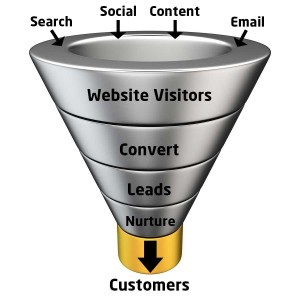
Online lead generation – Is your website working for your business?
As the hub of your online marketing, your website is the most important component of your web presence. The primary goal of your inbound marketing activities should be online lead generation – driving more traffic to your website and then converting the traffic into leads.
But is your website working for or against your business?
Are you getting traffic but have a high bounce rate or few conversions for all your efforts?
Maybe it’s time to take a look at your website through the eyes of your ideal client to get the truth about its effectiveness.
- People visit your site for a reason – do you know what that is and do you provide them with what they need so that they are satisfied?
- Is your website fresh and modern, incorporating all the latest design best practices?
- Does your content hold their interest, making them want more?
- Is what they are looking for easy to find, viewable on any device and presented in terms they understand?
- Are you wasting their time with elements on the page that don’t add value?
You must constantly take an objective and somewhat critical view of your website to ensure you are delivering the experience your visitor wants and expects from your business.
At a minimum, your website must include:
- Content that speaks to your visitor, showing you understand their needs and how you can help
- A modern design that aligns with the latest trends, projecting a consistent and powerful brand
- Visible contact forms and calls to action (CTA), encouraging lead capture
- Specific landing pages for marketing campaigns, to convert more traffic into leads
Content that speaks to your visitor
The content on your website must focus on your visitor’s needs and how you can help them better than anyone else. When your visitor sees a solution on your website that aligns with their needs or desires, they feel confident that you can help them. You must intimately understand your ideal client and be able to clearly describe the benefits of working with your company.
To help your visitor identify their solution with your company, you may need to have the following content readily available:
- Content pages that include a well-written FAQ (frequently asked questions) and customer case studies
- Customer testimonials that speak about how you helped them solve a problem
- Blog posts that illustrate your knowledge of your industry and your client’s issues
- Ebooks and whitepapers used as an incentive to entice your visitors to sign up for your email list
Work on strengthening your content on your website so that when your visitor arrives, they know they have found the right solution for their needs.
Modern design
It is very obvious when a website hasn’t had a design update in a while. Web design, like other creative industries, changes rapidly. Building your website in WordPress, however, makes it easier for you to update the design without disturbing your content.
There are a number of design trends that are evolving, however the critical ones you should be implementing now include:

Chrome icon – original and flat
- Mobile responsive design – With mobile Internet usage expected to overtake desktop usage in 2014 and mobile search rapidly growing, this is a must for small businesses. Responsive design enables you to get the benefits of supporting all devices from one website, reducing your overall costs to develop and maintain. Google, in fact, prefers responsive web design as the recommended mobile configuration if it makes sense for your business.
- Flat design – Flat design is a design philosophy that recommends simplicity, removing anything that creates the illusion of three-dimensions (such as beveled edges, gradients, drop shadows, and reflections) and focuses on use of simple elements, typography and flat colors. Start by switching your icons and buttons to a flat design and remove any extraneous drop shadows.
- Simple layout – Along with a flat design, a minimalist layout removes unnecessary elements and showcases your content. Simple doesn’t mean boring. Before you put something else on a page, ask if it enhances the user experience. If not, remove it. Not only will you make your website more appealing, you may also speed up your page load.
- Better typography – Websites are no longer restricted to web safe fonts. With Google fonts and CSS3 @font-face, you can select from a wider variety, making your headers more eye-catching. However, don’t go crazy with too many fonts. Like everything, simple is better.
Visible forms and calls to action
I still run across websites with no contact forms. Having an email address called info@ doesn’t cut it either (do people even monitor those email addresses?). People searching for solutions want to contact you when they are available, not when you are. Make it easy by having forms on all service pages so visitors can send in a request or question immediately. I’ve seen inbound leads increase substantially by simply adding a highly visible contact form.
Now combine a form with a CTA (call to action) incentive to increase your inbound leads even more. A CTA refers to active copy that entices a user to take action. Be specific and clear about what you want them to do rather than leaving it up to chance. The obvious CTAs are “register for this seminar”, “subscribe to our newsletter”, “buy now” or “add to shopping cart”.
Other more subtle or non-invasive calls to action are those used to move the visitor through the site on an information gathering process. Hyperlinks that help the visitor walk through a set of pages, next and back buttons or hyperlinked phrases such as “read our success story” are all types of calls to action that get your visitor to stay at your site longer.
Landing pages for specific campaigns
A landing page is any web page that a visitor can arrive at or “land” on, including your homepage. However, when spending marketing dollars, you should always direct visitors to a specific landing page that has been designed for a single focused objective. Driving online advertising, such as pay-per-click or sponsored posts, to your homepage is a waste of money.
Send the person to a page that explains the offer in more detail and directs them on what they need to do. Lead generation landing pages objective is to capture user information in return for an incentive and to give you permission to connect with the prospect again. Types of incentives include valuable content that is relevant to your target audience, such as an ebook, webinar registration or white paper.
Online lead generation – Make your website sell
If you aren’t converting website visitors into leads, you need to review all the pieces – target audience, offer, landing page, forms, creative and copy – to find out why. Make sure you are not putting up unnecessary roadblocks that eliminate key opportunities to convey your message, relate to clients and get your visitors to take action.
Your website can generate more leads and be a better marketing tool for your business. Nothing is better than having someone find your website, review what you offer, convert into a lead and then become a customer.
How is your website generating leads and selling for your business?
Article source: http://masterful-marketing.com/online-lead-generation/
